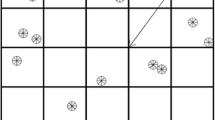Abstract
The shallow water equations (SWE) are a widely used model for the propagation of surface waves on the oceans. We consider the problem of optimally determining the initial conditions for the one-dimensional SWE in an unbounded domain from a small set of observations of the sea surface height. In the linear case, we prove a theorem that gives sufficient conditions for convergence to the true initial conditions. At least two observation points must be used and at least one pair of observation points must be spaced more closely than half the effective minimum wavelength of the energy spectrum of the initial conditions. This result also applies to the linear wave equation. Our analysis is confirmed by numerical experiments for both the linear and nonlinear SWE data assimilation problems. These results show that convergence rates improve with increasing numbers of observation points and that at least three observation points are required for practically useful results. Better results are obtained for the nonlinear equations provided more than two observation points are used. This paper is a first step towards understanding the conditions for observability of the SWE for small numbers of observation points in more physically realistic settings.
Similar content being viewed by others
References
Lacasta, A., Morales-Hernández, M., Burguete, J., Brufau, P., García-Navarro, P.: Calibration of the 1d shallow water equations: a comparison of Monte Carlo and gradient-based optimization methods. J Hydroinformatics 19(2), 282–298 (2003)
Bélanger, E., Vincent, A., Fortin, A.: Data assimilation (4d-VAR) for shallow-water flow: the case of the Chicoutimi river. Vis. Geosci. 8(1), 1–17 (2003)
Berger, M.S.: Nonlinearity and functional analysis. Academic Press (1977)
Cobelli, P.J., Petitjeans, P., Maurel, A., Pagneux, V.: Determination of the bottom deformation from space- and time-resolved water wave measurements. J. Fluid Mech. 835, 301–326 (2017)
Coron, J.M.: Control and nonlinearity. American Mathematical Society (2007)
Engl, H., Hanke, M., Neubauer, A.: Regularization of Inverse Problems. Kluver, Dordrecht (1996)
Gunzburger, M.D.: Perspectives in flow control and optimization. SIAM (2003)
Guo, L., Wang, Z.: Exact boundary observability for nonautonomous quasilinear wave equations. J. Math. Anal. Appl. 364(1), 41–50 (2010)
Ide, K., Courtier, P., Ghil, M., Lorenc, A.: Unified notation for data assimilation: operational, sequential and variational. J. Meteorol. Soc. Jpn. 75, 181–189 (1997)
John, F.: Partial differential equations. Springer (1982)
Kalnay, E.: Atmospheric modeling, data assimilation and predictability. Cambridge University Press (2003)
Kevlahan, N.K.R., Dubos, T., Aechtner, M.: Adaptive wavelet simulation of global ocean dynamics using a new Brinkman volume penalization. Geosci. Model Dev. 8(12), 3891–3909 (2015)
Khan, R.: A Data assimilation scheme for the one-dimensional shallow e quations, Master’s thesis, McMaster University (2016)
Li, T., Li, D.: Exact boundary observability for 1-D quasilinear wave equations. Math. Method Appl. Sci. 29(13), 1543–1553 (2006)
Maeda, T., Obara, K., Shinohara, M., Kanazawa, T., Uehira, K.: Successive estimation of a tsunami wavefield without earthquake source data: a data assimilation approach toward real-time tsunami forecasting. Geophys. Res. Lett. 42 (19), 7923–7932 (2015)
Nocedal, J., Wright, S.: Numerical optimization. Springer (2002)
Okada, Y.: Surface deformation due to shear and tensile faults in a half-space. Bull. Seism. Soc. Amer. 75, 1135–1154 (1985)
Pires, C., Miranda, P.M.A.: Tsunami waveform inversion by adjoint methods. J. Geophys. Res.: Oceans 106(C9), 19773–19796 (2001)
Protas, B., Bewley, T., Hagen, G.: A comprehensive framework for the regularization of adjoint analysis in multiscale PDE systems. J. Comput. Phys. 195, 49–89 (2004)
Stefanescu, R., Sandu, R., Navon, I.M.: POD/DEIM reduced-order strategies for efficient four dimensional variational data assimilation. J. Comput. Phys. 295, 569–595 (2015)
Spiteri, R., Ruuth, S.: A new class of optimal high-order strong-stability-preserving time discretization methods. SIAM J. Numer. Anal. 40, 469–491 (2002)
Stengel, R.F.: Optimal control and estimation. Dover (1994)
Steward, J.L., Navon, I.M., Zupanski, M., Karmitsa, N.: Impact of non-smooth observation operators on variational and sequential data assimilation for a limited-area shallow-water equation model. Q. J. R. Meteorol. Soc. 138(663, B), 323–339 (2012)
Tarantola, A.: Inverse problem theory and methods for model parameter estimation. SIAM (2005)
Tirupathi, S., Tchrakian, T.T., Zhuk, S., McKenna, S.: Shock capturing data assimilation algorithm for 1d shallow water equations. Adv. Water Resour. 88, 198–210 (2016)
Titov, V., Rabinovich, A., Mofjeld, H., Thomson, R., González, F.: The global reach of the 26 December 2004 Sumatra tsunami. Science 309, 2045–2048 (2005)
Vlasenko, A., Korn, P., Riehme, J., Naumann, U.: Estimation of data assimilation error: a shallow-water model study. Mon. Weather Rev. 142(7), 2502–2520 (2014)
Żabczyk, J.: Mathematical control theory. An introduction birkhȧuser (1995)
Zhu, K., Navon, I.M., Zou, X.: Variational data assimilation with a variable resolution finite-element shallow-water equations model. Mon. Weather Rev. 122(5), 946–965 (1994)
Zou, X., Navon, I., Dimet, F.L.: Incomplete observations and control of gravity waves in variational data assimilation. Tellus A: Dynamic meteorology and oceanography 44(4), 273–296 (1992)
Zuazua, E.: Propagation, observation, and control of waves approximated by finite difference methods. SIAM Rev. 47(2), 197–243 (2005)
Acknowledgements
We are grateful to our colleague S. Alama for his suggestion to use the Fourier transform to analyze the fixed point of the gradient descent algorithm.
Author information
Authors and Affiliations
Corresponding author
Additional information
Communicated by: Youssef Marzouk
Publisher’s note
Springer Nature remains neutral with regard to jurisdictional claims in published maps and institutional affiliations.
This work was funded by the NSERC Discovery Grants of N.K.-R. Kevlahan and B. Protas
Rights and permissions
About this article
Cite this article
Kevlahan, N.KR., Khan, R. & Protas, B. On the convergence of data assimilation for the one-dimensional shallow water equations with sparse observations. Adv Comput Math 45, 3195–3216 (2019). https://doi.org/10.1007/s10444-019-09733-6
Received:
Accepted:
Published:
Issue Date:
DOI: https://doi.org/10.1007/s10444-019-09733-6




